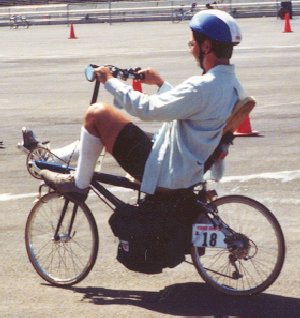#1 SWB Recumbent

FIGURE 1 : SWB Recumbent at Portland, Oregon IHPVASC
This page describes my short wheel base (SWB) recumbent bicycle. I've built a long wheel base (LWB) bike from discarded frames and Easy Racer plans a year or two ago. This is my first attempt at a design and the construction from tubing.
I completed it in time for the International Human Powered Vehicle Speed Championships in Portland, Oregon 1990. I'm into bicycle touring and the bicycle was designed for this rather than speed. But since I was going to the races to watch I wanted to take my own bike. A picture of the bike during the Practical Vehicle Competition is shown in Figure 1.
The bike is a SWB recumbent with above seat steering. It uses 20 inch tires front and rear. For touring it is nice to have the same size front and rear, less to carry in spares. A table of specifications is given in Table I.
The drive train has an intermediate shaft similar to a tandem but both chains are on the right side of the bike. One chain from the crank to a sprocket on the intermediate shaft. All gearing is done from the intermediate shaft to the rear wheel with three chain rings at the intermediate shaft and a five speed freewheel at the rear. A front deraileur shifts the chain rings but since this is within easy reach when seated no cable or shifter is used. The rear deraileur is shifter through a cable and shifter mounted on the handle bars.
The same shaft used as the drive train intermediate shaft also is the pivot for the rear suspension. This is a swing arm about the shaft with a large rubber bumper used for the spring.
During construction I found several minor problems. Stuff like the chain rings and chain hitting the rear triangle. These were solved by trial and error mostly.
When I designed the bike I decided to set the weight distribution to 40% front and 60% rear as a road bike is. The bike rode very well but the crank arms hit the front wheel. This would lock the front wheel and put the rider on the ground very quickly. I finally moved the seat forward six inches to avoid this problem. The bike handled very well in both cases. About the time I made this change I bought an Easy Racer fiberglass seat to replace the plywood initially used.
Initially panniers were mounted under the seat. This gave a good weight distribution. They do cause more wind drag there. I built a rear rack and moved the panniers to this rack when I moved the seat forward. Moving the seat forward put more weight on the front wheel so moving the panniers back made sense. It also allowed piling gear on top of the rack for camp touring.
The original design was to be collapsible for travel on planes, trains and busses. During construction much of this function was lost though.
This has been a very functional and good bike. As my first attempt there are a lot of things I'd do differently. After some fiddling and refinement it's proven to be a reliable bike. I've used it on several tours including our honeymoon and a month tour of the Northern Cascades and San Juan Islands.
